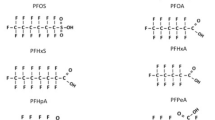Abstract
Polycyclic and halogenated aromatic hydrocarbons (PAHs and HAHs) can enhance the generation of reactive oxygen species (ROS) by inducing cytochrome P450 1A (CYP 1A) in vivo and in vitro. While the brain is vulnerable to oxidative injury, whether or not CYP 1A induction in the brain can produce measurable levels of oxidative damage has not been reported. The objective of this study was to investigate the effect of this induction on oxidative damage to the CNS. Time course changes in rat brain CYP 1A activity were determined by measurement of ethoxyresorufin O‐deethylase (EROD) activity in whole brain homogenates. Three days after exposure of rats to five daily injections of 3‐methylcholanthrene (3‐MC) an approximately sevenfold increase in EROD activity was observed. Hepatic levels were increased 60–100 fold. This increase in CYP 1A activity was not accompanied by increased protein or lipid oxidation as measured by tryptophan fluorescence and TBAR formation, or decreased glutamine synthetase (GS) activity. These findings indicate that if increased CYP 1A activity in the brain following 3‐MC treatment leads to increased ROS generation, the increase is insufficient to overwhelm the endogenous antioxidant defense system, produce detectable oxidative damage, and alter glutamate homeostasis.
Similar content being viewed by others
References
Costa LG: Signal transduction in environmental neurotoxicity. Annu Rev Pharmacol Toxicol 38: 21–43, 1998
Hankinson O: The aryl hydrocarbon receptor complex. Annu Rev Pharmacol Toxicol 35: 307–340, 1995
Poellinger L: Mechanism of signal transduction by the basic helix-loophelix dioxin receptor. In: P.A. Baeuerle (ed). Inducible Gene Expression, vol. 1. Birkhauser, Boston, 1995, pp 177–205
Schilter B, Omiecinski CJ: Regional distribution and expression modulation of cytochrome P-450 and epoxide hydrolase mRNAs in the rat brain. Mol Pharmacol 44: 990–996, 1993
Burke MD, Thompson S, Weaver RJ, Wolf CR, Mayer RT: Cytochrome P450 specificities of alkoxyresorufin O-dealkylation in human and rat liver. Biochem Pharmacol 48: 923–936, 1994
Simonian NA, Coyle JT: Oxidative stress in neurodegenerative diseases. Ann Rev Pharmacol Toxicol 36: 83–106, 1996
Halliwell B: Oxidants and the central nervous system: Some fundamental questions. Is oxidant damage relevant to Parkinson's disease, Alzheimer's disease, traumatic injury or stroke? Acta Neurol Scand 126(suppl): 23–33, 1989
Choi DW: Glutamate neurotoxicity and diseases of the nervous system. Neuron 1: 623–634, 1988
Oliver CN, Starke-Reed PE, Stadtman ER, Liu GJ, Carney JM, Floyd RA: Oxidative damage to brain proteins, loss of glutamine synthetase activity, and production of free radicals during ischemia/reperfusion-induced injury to gerbil brain. Proc Natl Acad Sci USA 87: 5144–5147, 1990
Sorg O, Horn TFW, Yu N, Gruol DL, Bloom FE: Inhibition of astrocyte glutamate uptake by reactive oxygen species: Role of antioxidant enzymes. Mol Med 3: 431–440, 1997
Montoliu C, Valles S, Renau-Piqueras J, Guerri C: Ethanol-induced oxygen radical formation and lipid peroxidation in rat brain: Effect of chronic alcohol consumption. J Neurochem 63: 1855–1862, 1994
Montoliu C, Sancho-Tello M, Azorin I, Burgal M, Valles S, Renau-Piqueras J, Guerri C: Ethanol increases cytochrome P450 2E1 and induces oxidative stress in astrocytes. J Neurochem 65: 2561–2570, 1995
Mishin VM, Pokrovskii AG, Pospelova LN, Liakovich VV: Interrelation of oxygen anion-radical generation and lipid peroxidation in liver microsomes. Biull Eksp Bio Med 80: 28–31, 1975
Park JK, Schigenaga MK, Ames BN: Induction of cytochrome P450 1A by 2, 3, 7, 8-tetrachlorodibenzo-p-dioxin or indolo (3, 2-b) carbazole is associated with oxidative DNA damage. Proc Natl Acad Sci USA 93: 2322–2327, 1996
Dhawan A, Parmar D, Das M, Seth PK: Cytochrome P-450 dependent monooxygenases in neuronal and glial cells: Inducibility and specificity. Biochem Biophys Res Commun 170: 441–447, 1990
Unkila M, Pohjanvirta R, Tuomisto J: Biochemical effects of 2,3,7,8-tetrachlorodibenzo-p-dioxin (TCDD) and related compounds on the central nervous system. Int J Biochem Cell Biol 27: 443–455, 1995
Zhang QY, Kaminsky L: Induction of CYP 1A by beta-naphthoflavone in IEC-18 rat intestinal epithelial cells and potentiation of induction by dibutyryl cAMP. Biochem Biophys Res Commun 233: 623–626, 1997
Unkila M, Pohjanvirta R, Honkakoski P, Torronen R, Tuomisto J: 2,3,7,8-tetrachlorodibenzo-p-dioxin (TCDD) induced ethoxyresorufin-O-deethylase (EROD) and aldehyde dehydrogenase (ALDH3) activities in the brain and liver. A comparison between the most TCDD-susceptible and the most TCDD-resistant rat strain. Biochem Pharmacol 46: 651–659, 1993
Buege JA, Aust SD: Microsomal lipid peroxidation. Meth Enzymol 52: 302–310, 1978
Davies KJ, Lin SW: Protein damage and degradation by oxygen radicals. II. modification of amino acids. J Biol Chem 262: 9902–9907, 1987
Meister A: Glutamine synthetase from mammalian tissues. Meth Enzymol 113: 185–199, 1985
Svingen BA, Buege JA, O'Neal FO, Aust SD: The mechanism of NADPH-dependent lipid peroxidation. The propagation of lipid peroxidation. J Biol Chem 254: 5982–5989, 1979
Geng J, Strobel HW: Expression, induction and regulation of the cytochrome P450 monooxygenase system in the rat glioma C6 cell line. Brain Res 784: 276–283, 1998
McFarland VA, Clarke JU: Environmental occurrence, abundance, and potential toxicity of polychlorinated biphenyl congeners: Considerations for a congener-specific analysis. Environ Health Perspect 81: 225–239, 1989
Suarez KA, Carlson GP, Fuller GC: Effect of phenobarbital or 3-methylcholanthrene pretreatment on carbon tetrachloride-induced lipid peroxidation in rat liver. Toxicol Appl Pharmacol 34: 314–319, 1975
Nordmann R: Alcohol and antioxidant systems. Alcohol 29: 513–522, 1994
Roseman JE, Levine RL: Purification of a protease from Escherichia coli with specificity for oxidized glutamine synthetase. J Biol Chem 262: 2101–2110, 1987
Norenberg MD, Martinez-Hernandez A: Fine structural localization of glutamine synthetase in astrocytes of rat brain. Brain Res 161: 303–310, 1978
Wilson JX: Antioxidant defense of the brain: A role for astrocytes. Can J Physiol Pharmacol 75: 1149–1163, 1997
Morse DC, Stein AP, Thomas PE, Lowndes HE: Distribution and induction of cytochrome P450 1A1 and 1A2 in the rat brain. Toxicol Appl Pharmacol 152: 232–239, 1998
Author information
Authors and Affiliations
Rights and permissions
About this article
Cite this article
Liu, L., Bridges, R.J. & Eyer, C.L. Effect of cytochrome P450 1A induction on oxidative damage in rat brain. Mol Cell Biochem 223, 89–94 (2001). https://doi.org/10.1023/A:1017904912654
Issue Date:
DOI: https://doi.org/10.1023/A:1017904912654




